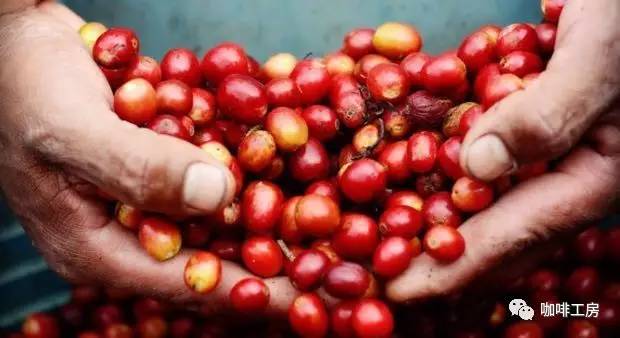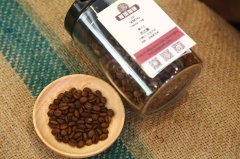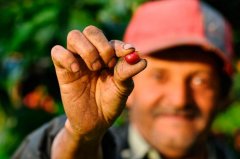Sidamo Sakuran is the champion bean? How to make Sakuran taste better? What are the flavor characteristics?
Sidamo Sakuran is the champion bean? How to make Sakuran taste better?

Planting place:
Only the sun-tanned coffee beans produced by "Buku Abel" in Hambella producing area are the real Sakuran.
Hambella (Humbela) is located in the largest coffee producing area of Ethiopia, GUJI, and the west is opposite the mountain of Yegashefi kochore, which is the highest sub-area in Ethiopia.
At present, there are nearly 20 processing plants in the Hambella producing area, and of all the manors and processing plants, only the sun-tanned coffee from Buku Abel Manor is what we call this Sakuran.
Buku Abel is a small village surrounded by mountains on the African continent at an altitude of 2280 meters. December is its coffee harvest season. Whenever the mountains are covered with red and mature coffee cherry, the village is neatly arranged on African tanning beds. This is where "Sakuran" deals with.
All the coffee trees in Buku Abel Manor are planted at an altitude of 2250 to 2350 meters above the hillside. The red fructose picked by farmers does not begin to be treated in the sun until the sugar content is more than 30. The humidity of the red fruit needs to be ensured in the first two days of the sun, so that it has time to fully ferment. At night, the temperature here will drop to about 12 degrees, which ensures that the red fruit will not be overfermented.
After 18 days of sun treatment, the peel and pulp have been completely dehydrated, and we can easily get the coffee raw beans inside. Pack the raw beans and put them in a warehouse with 12-22 degrees Celsius and 45-55% humidity. After about 50 days of bean cultivation and further dehydration, shelling and screening are carried out when the moisture content reaches about 11% for formal market sale.
Huakui treatment plant is located in buku abel village, which is 2200 meters above sea level. From the beginning of cultivation, it has been chosen as a noble "family environment"-rich humus reddish brown soil, and given shade and care to "Enset" tree species, so that Sakui receives sufficient sunlight and produces rich flavor without consuming too much nutrients, thus retaining more essence in the inside of the coffee fruit. In the harvest and treatment season (December-January), its unique growth environment and natural climate created the unique flavor of Huakui. The sugar content of the red fructose we are picking is more than 30 before we start sun treatment. In the first two days of the sun, we should ensure the humidity of the red fruit so that the fructose begins to ferment fully. At the same time, the high-altitude geographical location, so that the night temperature of the treatment plant can be reduced to about 12 degrees Celsius, and will not produce the smell of excessive fermentation because the temperature is too high. When the temperature is relatively high at noon, we will cover in time to prevent sunburn of red fruit. Choose only all red fruits, fully ripe coffee cherries, all manual picking, African scaffolding to dry, limit the thickness of the fruit layer and turn it regularly for 24 hours to ensure uniform sun exposure and ventilation and a more accurate grasp of the fermentation degree.
In order to prevent sudden rain at night, it will be wrapped in thick plastic sheeting. In this way, the red fruit is fermented and dehydrated at a lower temperature. After 18 days of sun treatment, when the moisture content of raw coffee beans is reduced to about 13%, stop sun treatment, put it in sacks, put it in the warehouse under natural conditions of 12-22 degrees Celsius and 40-50% humidity, raise raw beans and further dehydrate for about 50 days. When the moisture content of raw beans reaches about 10, the transportation treatment plant will be shelled and screened for sale.
How to handle it:
Natural solarization (African drying bed):
Spread the coffee fruit directly on the cement floor or on the drying rack in order to make the coffee dry and easy to preserve. It usually depends on the weather, and the drying time is about 2-4 weeks.
Coffee usually used for commercial purposes will be dried on the cement floor. Keep rolling the coffee fruit in time so that the back of the coffee is heated evenly, which is good for drying, and at the same time, it also avoids mildew caused by the bottom touching the ground for too long.
Hand-selected fruits and coffee beans used to make boutique products are treated in the sun with African Bed (African drying bed). Coffee fruits are sunbathed on transparent beds with mesh, and the thickness of the shelves varies according to local conditions.
Washed complete washing method:
The peel, pulp and mucous membrane are removed by washing and fermentation. the treatment plant that uses the washing method must rely on the water source, build a washing pool, and be able to introduce an endless supply of live water. During the treatment, the finished beans are put into the pool and passed back and forth, using the friction of beans and the power of running water to wash the coffee beans until smooth and clean.
After washing, at this time, the coffee beans are still wrapped in the pericarp with a moisture content of 50%. They must be dried to reduce the moisture content to 12%, otherwise they will continue to be mellow, moldy and rotten.
Because of the shortage of water resources in Africa, water washing plants in many producing areas directly purchase freshly picked coffee cherries from different nearby villages or planting areas for unified treatment.
Hand punching parameters are recommended:
[sun Huakui]: it is recommended to use 15 grams of powder at 90 degrees water temperature, 3.5 Fuji grindability 3.5 V 60 filter cup, water powder ratio 1:15, the first water injection 30g, steaming 30s, the second water injection 104g water cut off, the second water injection to 225g water, not the water in the tail section, the extraction time is about 2Rd 02s.
[water washing Huakui]: it is recommended to use 15 grams of powder at 92 degrees water temperature, 3.5 Fuji grindability 3.5 V 60 filter cup, water powder ratio 1:14, the first water injection 30g, steaming 30s, the second water injection 110g water cut off, the second water injection to 215g water, the water in the tail section is not needed, the extraction time is about 2Rd 05s.
Cup test flavor: passion fruit, rose flavor, strawberry jam, sweet and sour berries, peach pulp, black tea tail rhyme.
Important Notice :
前街咖啡 FrontStreet Coffee has moved to new addredd:
FrontStreet Coffee Address: 315,Donghua East Road,GuangZhou
Tel:020 38364473
- Prev

Does the lion king in Sidamo, Ethiopia have lions? What's the difference between sunbathing and washing raw beans?
Does the lion king in Sidamo, Ethiopia have lions? What's the difference between sunbathing and washing raw beans? Origin: name: Ethiopia location: East African Capital: Adis Abba Addis Ababa Religion: Christian main language: Amharic time Zone: GMT+3 Metrology: metric (Metric) currency: bill Birr (1 $20 birr) Agricultural products (Export): coffee, flowers,
- Next

Why does the candle taste good in Sidamo? Do the coffee beans in Sidamo taste good?
Why does the candle taste good in Sidamo? Do the coffee beans in Sidamo taste good? Sidamo, which grows in the southernmost Ethiopian plateau between 4600 and 7200 feet above sea level (Sidamo province), is a famous boutique coffee area in southern Ethiopia, bordering Kenya, southeast of Gemma, just south of the capital, usually sweet and loved by most people, with an annual output of about
Related
- Detailed explanation of Jadeite planting Land in Panamanian Jadeite Manor introduction to the grading system of Jadeite competitive bidding, Red bid, Green bid and Rose Summer
- Story of Coffee planting in Brenka region of Costa Rica Stonehenge Manor anaerobic heavy honey treatment of flavor mouth
- What's on the barrel of Blue Mountain Coffee beans?
- Can American coffee also pull flowers? How to use hot American style to pull out a good-looking pattern?
- Can you make a cold extract with coffee beans? What is the right proportion for cold-extracted coffee formula?
- Indonesian PWN Gold Mandrine Coffee Origin Features Flavor How to Chong? Mandolin coffee is American.
- A brief introduction to the flavor characteristics of Brazilian yellow bourbon coffee beans
- What is the effect of different water quality on the flavor of cold-extracted coffee? What kind of water is best for brewing coffee?
- Why do you think of Rose Summer whenever you mention Panamanian coffee?
- Introduction to the characteristics of authentic blue mountain coffee bean producing areas? What is the CIB Coffee Authority in Jamaica?

